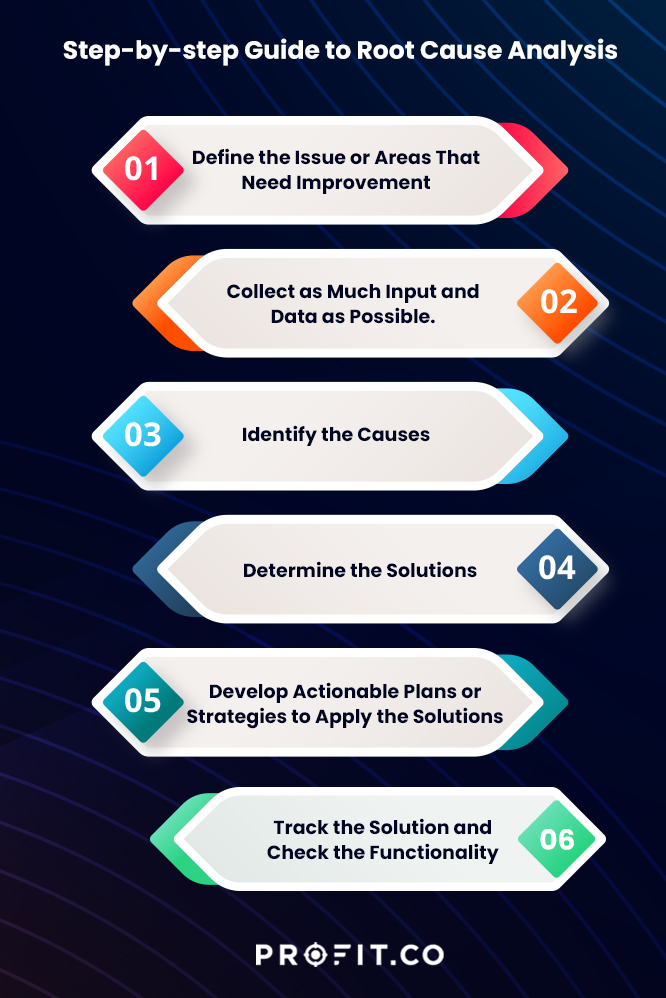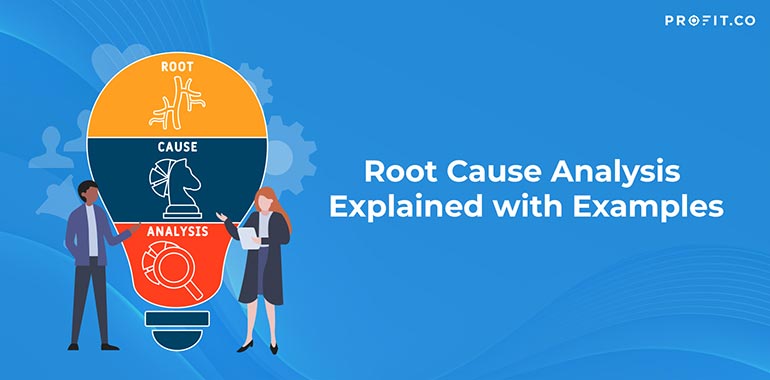Introduction
Root cause analysis discovers the root causes of issues and comes up with appropriate solutions. It’s easier to prevent and resolve underlying problems than to treat symptoms proactively.
RCA looks past the superficial causes and effects and highlights where the system or processes failed, causing the problem in the first place.
Let’s examine RCA in-depth, types, what it involves, how to go about it, and tips to ensure you optimize its benefits.
Table of Contents:
What is Root Cause Analysis?
The concept of root cause analysis involves problem-solving techniques or approaches. These approaches collectively establish the cause of inconsistency or non-compliance issues.
RCA is the process of identifying, explaining, and resolving a problem. The root cause is the primary or underlying explanation of the issue.
It’s also the specific point along the causal chain where intervening or implementing disciplinary action can prevent the issue. You can leverage the root cause analysis to assess incidents or concerns to help you determine the following:
- What exactly happened?
- How did it occur?
- Why did it occur?
- Actions to prevent the recurrence of the issue
Ultimately, root cause analysis prioritizes three goals:
- The first goal is to find the root or primary cause of a problem
- The second is determining how to leverage or resolve the root cause issues.
- The third and most essential goal is implementing the root cause findings to prevent potential problems.
We cannot solve our problems with the same thinking we used when we created them.
Why Should You Conduct Root Cause Analysis?
In most cases, we resolve the symptoms of the issue and assume we have fixed the entire problem. In reality, we only address the first level of the issue instead of the root cause.
RCA offers a structured way of problem-solving that applies to different industries and situations. It helps organizations recognize weak points in the structures or procedures. You need to evaluate what happened and what made it happen and then establish the areas you should modify or strengthen.
Book a free demo with our team to learn more about how OKR software can optimize your organization’s performance!
Types of Root Cause Analysis
Three primary root cause types can potentially affect an issue:
- Physical Causes
These root causes occur due to issues with the physical parts of a system, like equipment malfunction and hardware failure.
- Human Causes
These causes happen as a result of human error. For instance, under-skilled employees need more knowledge and skills to handle tasks. They should have followed the instructions correctly or taken necessary actions.
- Organizational Causes
These causes occur when companies use subpar or faulty processes and systems. They happen in situations such as mishandling property or staff, making unwise decisions and issuing incomplete instructions.
For instance, team leaders can give vague instructions, select the wrong person to handle a task, or fail to implement tools to evaluate quality.
Root Cause Analysis Examples
A great example of RCA using the Fishbone diagram is in the IT industry. Let’s use a situation where the IT team discovers a major bug during the testing phase of User Acceptance Testing (UAT) of the software they are working on.
The team and project manager decide to conduct an RCA to resolve the current issue and identify the root cause of the problem. The diagram has the following primary categories:
- Coding
- Testing
- Technical Design
- Requirements
The next step is brainstorming to see whether interrelated issues possibly caused the problem. The project manager then evaluates the results to identify as many potential causes related to the main categories listed above.
Some questions the team could ask are:
- Did anyone review the requirements?
- Did the technical design team truly understand the software requirements?
- Did the team follow the correct coding practices when developing the app?
If you identify the problem is in the testing phase, you can expand the diagram. Adding new branches will help pinpoint the aspects of the testing phase that caused the root issue.

How to Perform Root Cause Analysis
The main aim of root cause analysis is to determine the underlying cause of an issue. These insights benefit you in the present and future by improving the product or service quality. However, the only way to achieve the intended benefits is by performing RCA systematically. During the process, you or your team should remain on each step until you exhaust all angles before moving on.
Step-by-step Guide to Root Cause Analysis
There are different ways to establish the primary issue, but the RCA framework remains the same.
Step 1: Define the Issue or Areas That Need Improvement
The first step is clearly and precisely defining the problem. The team in charge of the RCA should then analyze the problem definition to determine its viability and accuracy.
Step 2: Collect as Much Input and Data as Possible.
The next step is collecting adequate evidence or information about the problem statement. Your focus should be on quantitative and qualitative data, as it helps you understand the issue comprehensively.
Step 3: Identify the Causes
Once you have enough data, it’s easier to evaluate every cause and pinpoint the root cause that triggers the issue.
Step 4: Determine the Solutions
This step focuses on finding solutions for the particular root causes you outlined in step 3. The solutions can be:
- Preventive Solutions – These are detailed long-term measures that address the root cause to prevent future recurrence. Managers can familiarize themselves with project management tools as a preventive solution.
- Corrective Solutions – These are stopgap or short-term solutions that address the current issues, targeting the direct cause of the problem based on evidence
Step 5: Develop Actionable Plans or Strategies to Apply the Solutions
After defining the solutions, you need to devise a plan to implement the solutions systematically. This fifth step involves determining and recording:
- Necessary actions to apply the solutions
- The resources these actions need
- Schedule of the particular actions
- The people responsible for the actions
- Other aspects that revolve around implementing the solutions
Step 6: Track the Solution and Check the Functionality
The last crucial step is regular monitoring of the implemented solutions. Doing so ensures the solutions remain feasible to prevent the root causes from recurring.
Tools and Techniques Used in Root Cause Analysis
The next step after identifying the root cause of an issue is selecting the proper RCA technique to address it. Let’s explore the primary techniques you can use to help you understand how to apply them to your case.
- The 5 Whys Analysis
5 Whys analysis involves answering several follow-up questions about the issue. This technique gives you deeper insights into the problem.
Checking whether the answers interconnect helps clarify vague details about the problem, and it gives you a clearer picture while strategically highlighting the actual cause of the issue.
- FMEA or Failure Mode and Effects Analysis
This technique identifies the failures within a process or design. It applies to any stage of a process, including:
- Inspection
- Implementation
- Designing
- Planning
Failure Mode and Effects Analysis focuses on the failure modes and suggests corrective action. This technique has two particular aspects:
- Failure Mode – This involves pinpointing the different modes or types and ways in which something can go wrong
- Effects Analysis – It involves evaluating the consequences and effects of every failure mode you identified
- CED (Cause-and-Effect Diagram) or Fishbone Diagram/Ishikawa Diagram
This technique is useful in complex RCA, where you can identify the root cause. The diagram has all possible root causes linked to a particular problem.
The fish head represents the problem, while other significant causes branch out of the spine. The secondary causes form the spine’s sub-branches.
It would help if you tackled each branch at a time by brainstorming and questioning the causes. From the beginning, you should include these standard categories or causes in your root cause analysis report:
- Human resources or people
- Technology, equipment, or machinery
- Consumables or materials
- Systems, processes, or methods
- Surroundings or environment
- Pareto Analysis or Diagram
This technique uses the Pareto Principle. The Italian economist Vilfredo Pareto explains through the Pareto chart that in most adverse events, 80% of the effects result from about 20% of the causes.
The main goal is to determine the primary causes of most of the issues, and you can achieve this by examining and assessing the quantitative data on the causes.
Best Practices
Recurring failure during a process harms the resources’ maintenance, production, or safety. This, in turn, significantly impacts the overall profitability.
There are particular best practices you should consider to help you identify and sustain corrective measures, including:
- Remember, there are likely multiple interrelated root causes
- Focus on correcting the actual cause of the issue instead of the symptoms
- Handle the issue methodically to collect viable cause-effect evidence to prove the root cause claims
- Consider why and how adverse events occurred instead of who’s responsible. It’s about the processes but not the team
- The analysis participants should have a profound understanding of different RCA and how to apply them
- The team conducting the RCA should agree on the root causes they identify
- Recognize that the necessary solutions may affect the company culture. The affected people may present some resistance when you’re implementing the solutions. However, they will prove to be helpful at the time of project planning.
FAQs
- What are the 5 whys?
The 5 whys is an RCA technique that helps determine an issue’s root cause. They are not any five random questions but rather strategic, and the answer to one “why” should direct the next question.
- How often should you perform RCA?
There’s no upper limit. You can conduct an RCA frequently because it depends on how issues occur. Your conclusions will determine the best time to schedule the subsequent RCA, but it’s best to have one at least once annually.
- How much time does RCA take?
The RCA process can take hours, days, or weeks, depending on the magnitude of the issue at hand. In most cases, it happens as a series of brief sessions over several weeks.
Final Thoughts
When faced with a problem, the primary challenge is not addressing it alone but finding the root cause and ways to prevent the occurrence in the future. One of the most successful goal management platforms is the OKR methodology, where measurable key results define the objectives of an organization. Managers can now use agile OKR software to efficiently manage all their project management goals. The Objectives can be set after taking feedback from root cause analysis of previously failed practices or projects so that there is progressive learning in the project management practices of an organization
You can get started on Profit.co completely free today!

